- [email protected]
- National Animal Rights Association, Suite 10684, 26/27 Upper Pembroke Street, Dublin 2, D02 X361.
Horse Carriages
It is still legal in Ireland for horses to be used to pull carriages. Most of this takes place in Dublin, as a tourist attraction.
Before you pay for animal cruelty, think about the following:
- It is unnatural for horses to be in a city centre environment, let alone to be forced to carry and pull up to 6 times their own weight.
- During the course of the day, they get very little access to food or water, and their "resting" period consists of them still being attached to a carriage, and tied to a post or railings - often in a way that prevents them from lowering their heads.
- No one monitors how many hours horses are forced to work, or how many hours rest they get.
- Where are they kept at night? What happens when they are too old, sick, or are no longer of use to their "owners"?
- Has anyone ever witnessed these horses being broken ("trained") for the purpose of horse carriages?
- There is a genuine inevitability that a road traffic accident will occur, due to a horse rearing or being spooked by oncoming vehicles.
- Apart from the obvious welfare issues, it is completely unethical to use any animal in this way.
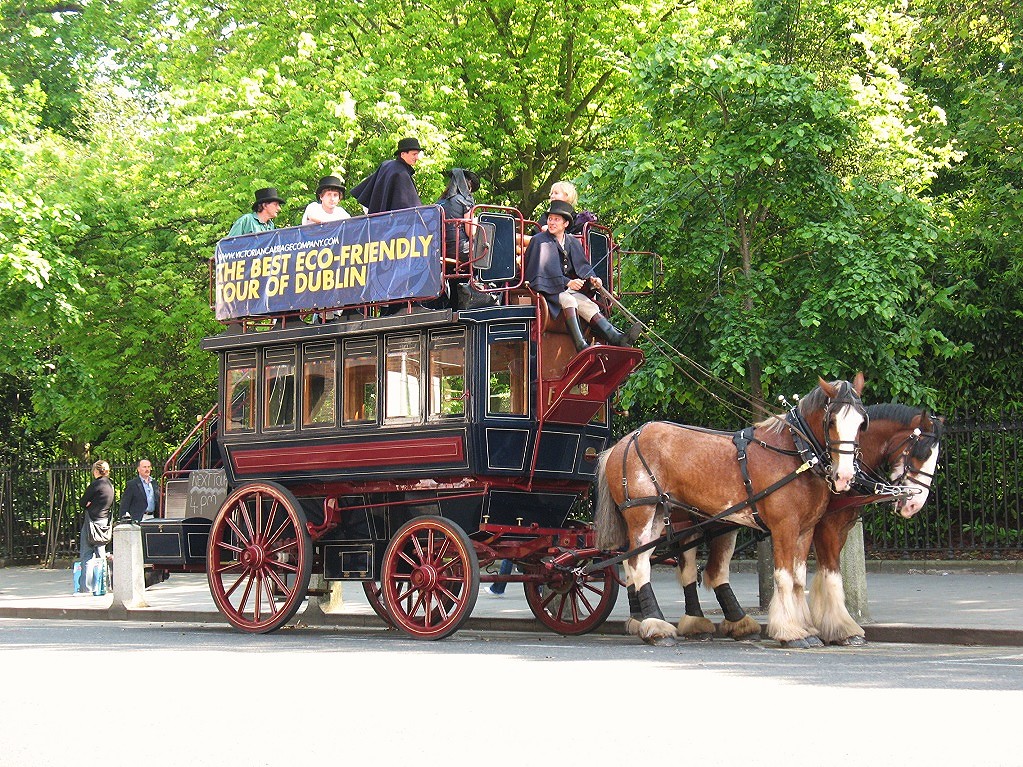
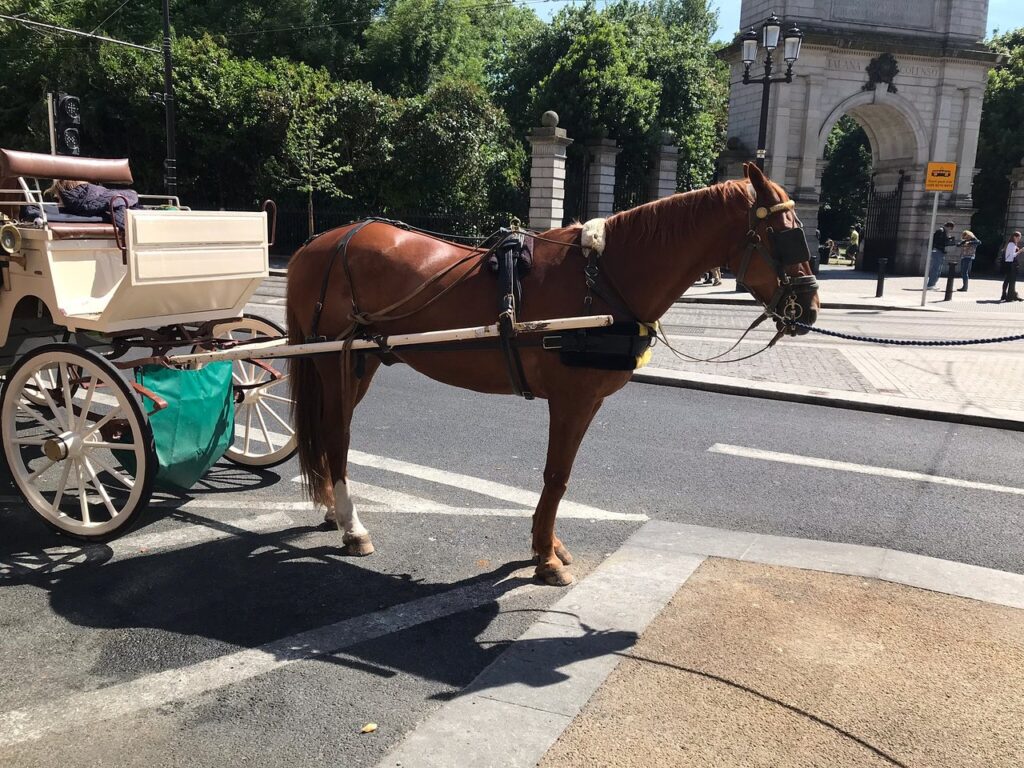
Introduction
A ride on a horse-drawn vehicle might at first appear to be a romantic, nostalgic journey to a bygone era when cars and buses were absent. However, this industry is actually
fraught with potentially serious problems for both animal welfare and public safety.
There are also major hurdles relating to first establishing and then properly enforcing an appropriate regulatory framework. In addition, substantial public liability risks are a key factor.
Visible injuries
Even for healthy horses, drawing a vehicle carrying anything from two to nine people through city streets is not an easy task.
Holly Cheever D.V.M., a respected equine vet who has treated carriage horses in New York, points out, ‘Lameness and hoof deterioration are inevitable when a horse spends its life walking or jogging on the unnaturally concussive asphalt of city streets’.
But these are merely the visible consequences of requiring horses to pound the concrete and cobbled streets of towns and cities. There are far more serious outcomes that go beyond horses being unable to work – and, in fact, can result in their death.
Toxic pollution
The demand for horse-drawn rides peaks during the summer months when the tourist trade is at its busiest. This is also the time of year when roads are most congested. Air pollution, has an adverse effect on horses’ respiratory systems. The effect of sunlight on pollution generated by vehicle exhausts can create toxic and irritant low-level ozone smog. This is particularly bad because in the hot summer weather, just when the surrounding air is at its most irritant, the hard-worked horses will be breathing most heavily to cool their bodies down. As a result, they will be drawing in huge lung-fulls of toxins.
The leading medical journal, The Lancet, has noted that animals exposed to ozone pollution have suffered emphysema, cancer and accelerated ageing, stating that ‘in animals exposed to ozone the mortality from lung infections is increased’. U.S. Veterinarian Jeffie Roszel has studied the breathing problems experienced by horses
used to draw vehicles in traffic. He found that the ‘tracheal washes and samples from respiratory secretions of these horses showed enormous lung damage, the same kind of damage you would expect from a heavy smoker’. Horses’ nostrils are usually only 3 to 3.5 feet above street level, so these animals are ‘truly… living a nose-to-tailpipe
existence’.
Heat stroke, dehydration…
Even if largely restricted to pedestrianised areas, the horses are still being exposed to the life-threatening risks of heat stroke and colic (a major cause of death in adult
horses). David Freeman, a specialist equine vet at the University of Oklahoma, has warned that periods of intense exercise followed by periods when the horse is simply standing around, plus a limit on the horse’s access to small and infrequent amounts of water, increase the risks of heat stroke and colic.
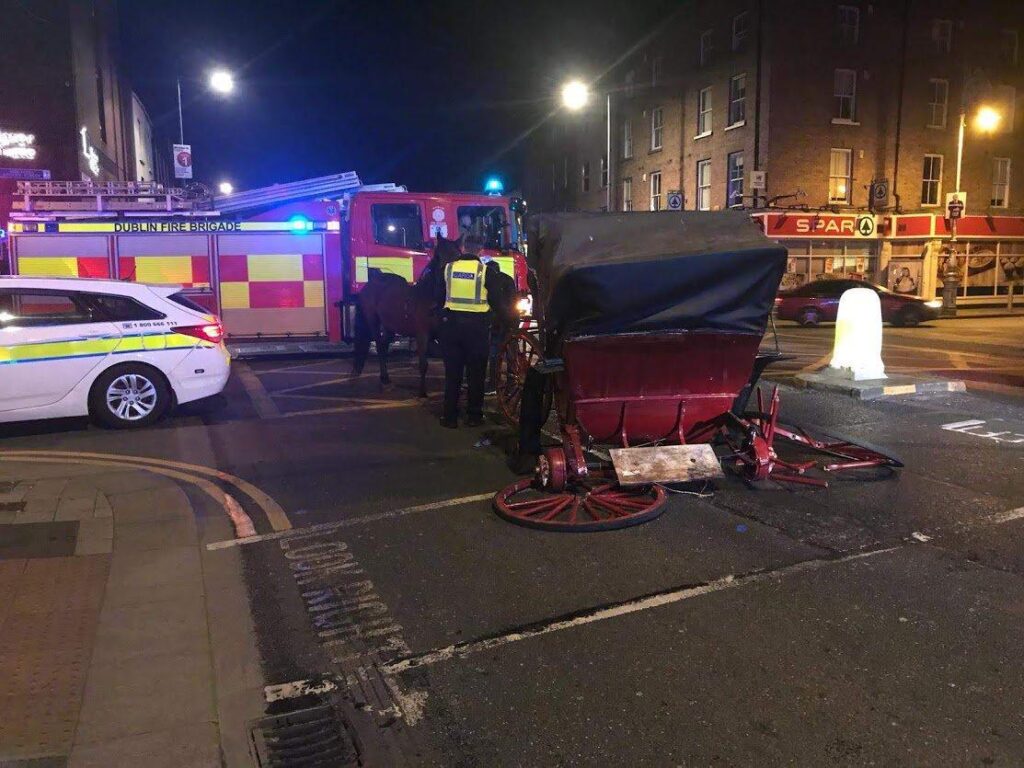
During these summer months, horses suffering from dehydration or heat stress can die in just a few hours. Symptoms of heat prostration in horses include flared nostrils, brickred mucus membranes, trembling, and a lack of sweat production on a hot day. Some U.S. regulations forbid horse-drawn vehicles when the temperature reaches a certain degree. A problem associated with such edicts is that official weather bureau readings do not accurately reflect the temperature on city streets. A study published by Cornell University found that the air temperature recorded by the weather bureau can be nearly 50 degrees Fahrenheit cooler than the actual asphalt temperature. And the New York City Department of Transportation found that asphalt surfaces can reach 200 degrees Fahrenheit.
These discrepancies can be life threatening particularly for a large horse, like one of the draft breeds, as they are greatly challenged in their ability to dissipate body heat into an increasingly warm environment. The horse can lose 8-10 gallons of fluid with exercise, but if the air is damp, cooling by evaporation cannot occur. If dehydrated and unable to produce sweat, anhydrosis ensues and can kill.
The stop/go work pattern for horses is also likely to bring an increased risk of the highly dangerous condition equine myoglobinuria, or azoturia. Dr Tim O’Brien, a leading advisor to animal welfare organisations such as Compassion in World Farming, comments: ‘This presents itself when horses are worked, suddenly rested, then abruptly returned to work. It appears to be caused by the sudden liberation of large amounts of accumulated lactic acid when the animal is returned to work. The horse’s limbs become stiff. The hindquarter muscles are so rigid that they can feel like wood. Urine is sometimes retained, the bladder having to be relieved by the introduction of a catheter. Once the condition has developed, the horse is in severe danger.’

The feeding of horses
With reference to feeding horses during working hours, this is sometimes done by the use of a nosebag, which is suspended from the head of the horse. However, Dr Tim
O’Brien notes that the use of nosebags is a completely unnatural way for a horse to feed, and is well known to present increased risk of respiratory problems over a period of time, as a result of inhaling food dust from the bag. The effect of cumulative welfare
‘insults’.
The problems listed above – including respiratory disease, heat stroke, dehydration and lameness – tend to result from cumulative welfare ‘insults’. To deny their existence or the effect that pollution and stress have in accelerating them is to ignore authoritative published research on the subject. Holly Cheever D.V.M. is one such expert, having studied pathologists’ investigations into working horses. She stated in a submission to Oxford City council, which was considering, but later abandoned, plans to introduce horse-drawn vehicles: ‘I must politely disagree with any veterinarian who claims that there is no increase in respiratory diseases in horses worked for long periods in congested urban environments, compared to their rural environments.’ It is interesting to note that the average working life of a police horse in New York City is 15 years. This compares with less than four years for a carriage horse.
The deadly consequences of horses becoming ‘spooked’
”Spooking’ can happen to even the best-trained and well-mannered horse… there is no such thing as an unspookable horse, nor can the average driver control it once it bolts.’’ Holly Cheever D.V.M.
Horses and city traffic can be a deadly mix. Contrary to operators’ claims, most horses are not at all comfortable working among cars and lorries. Animals becoming ‘spooked’ in traffic have frequently caused accidents – both minor and fatal. Spooking is a term to describe a horse panicking and temporarily being out of the control of the vehicle’s driver. A car horn or something as minor as a pedestrian walking in front of the horse could trigger this. In the majority of cases, the cause of an incident can never be explained.
There are numerous documented cases of both animal and human injuries, sometimes fatal, after carriage horses have become ‘spooked’. A US survey of national carriage horse accidents revealed that:
• 85% of all accidents were the result of an animal spooking
• 70% of the time there was a human injury
• 22% of the time there was a human death
In New York City, which has the highest carriage horse accident rate in the U.S., 98 percent of the horses who ‘spooked’ became injured. Injuries and fatalities resulting from collisions between cars and carriage horses have occurred in almost every city that allows carriage horse rides.
The use of blinkers
The use of blinkers does not eliminate the risk of accidents. Blinkers are often used in an effort to help maintain the animals’ concentration, and yet they can actually have the opposite effect. If horses are startled – for instance, by a noise or by being touched – they may panic and yet are further disturbed by being unable to see what is happening around them. Even in horse racing, where the distractions from other runners are routine
and familiar, the use of blinkers is being debated. During the 2001 Grand National, Paddy’s Return created havoc at Canal Turn bringing down several horses. Racing authorities believe that the use of blinkers could have contributed to the accident.
Hygiene
The presence and disposal of manure is an easily neglected problem. New York City faced protests and calls for compensation from restaurant and café owners who said that tourists were complaining of the smell. It was reported that carriage horse drivers responded by withholding food and water from horses during working hours – the purpose being to avoid ‘unsightly pools of urine and faeces’.
Injured and retired horses
Animal Aid has collated evidence demonstrating that a large number of racehorses in the UK are simply discarded or killed for pet food once their racing days are over. In the US this is also the fate of horses when they can no longer pull heavy carriages. We would therefore be concerned about the fate of any injured or worn-out omnibus horses, once they were no longer commercially useful.
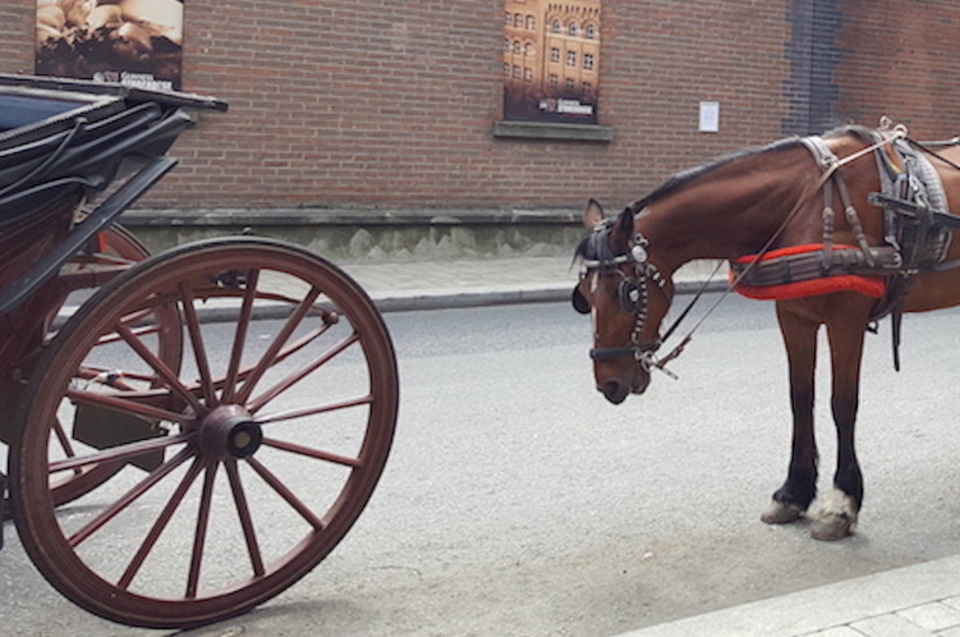
The impact on the tourist trade
Some people argue that the presence of horse-drawn vehicles can act as a lure to tourists. The reality is that the majority of people visit a town or city because of its amenities, ambience, history and architecture. Greta Bunting, author of ‘The Horse: The Most Abused Domestic Animal’ has commented: ‘Out of ignorance of the abuse, tourists may ride in a carriage when [visiting a city], but that is not their purpose in going.’
In fact, far from attracting tourists, many people quite rightly find the sight of horses in modern traffic upsetting and distressing. Some tourists could even make a conscious decision to avoid re-visiting a town or city because of their experience.
London, Paris and Toronto say ‘no’
Among the major cities that have imposed a prohibition on the use of horse-drawn vehicles for tourism – either for humane or congestion reasons – are London, Paris, Toronto and Beijing. In the US, bans have arisen directly from protests by residents. Palm Beach and Las Vegas, as well as Biloxi and Santa Fe are among the affected cities.
Conclusion
• As this report has documented, the continuation of horse-drawn carriages exposes these animals to unnecessary welfare risks, and also leaves the council open to public criticism when the first regulatory failure and/or accident is exposed.
• Animal Aid, and the signatories to this report, understand that it is the duty of councillors to work with tourist authorities to promote their town/city and explore all avenues that serve to make a visit both enjoyable and unique. By banning horse-drawn vehicles, a clear message is being sent that the council is no longer prepared to
compromise the safety of visitors, residents, or animals for a tourist gimmick.
• However, if the industry was to continue, there will be immense controversy when the first horse collapses, is injured, or dies. It hardly needs saying that any injury to a member of the public will not go unnoticed either.
• Not only would any such incident reflect poorly on the local authority’s ability to regulate vehicle operators but it could also result in a financial penalty being incurred by the town/city.
• Furthermore, whatever the legal position, it is the local authority that will be held responsible in the eyes of the public, the media and animal advocates.
Apart from the welfare and safety issues mentioned in the above report, it is completely unethical for any animal to be used in this way.
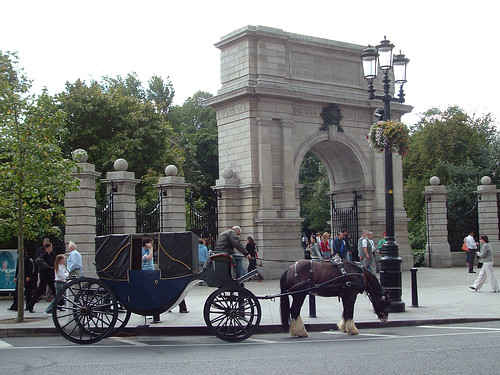
So, what are we doing about it?

Protests
We have protested the horse carriage ranks at Stephen's Green Park before, despite the violence, threats and intimidation we received from the drivers.

Awarness
As this is a tourist attraction, handing out leaflets to members of the public is key to tackling this industry.

Lobbying
We have lobbied Dublin City Council before, requesting that they refuse to renew their licences. Help us achieve this - contact your local councillors today!
We have various campaigns running at any one time. Please click to learn about more issues!
Subscribe to our newsletter
NARA is a legal, grassroots level organisation that only operates within the law. Information on this website is for the purpose of legal protest and information only. It should not be used to commit any criminal acts or harassment. NARA is not affiliated to any other animal rights group. NARA has no links or involvement with the Animal Liberation Front or the Animal Rights Militia. Any articles published on this web site relating to illegal activities are posted for the sole reason of publishing news related to animal rights, and are not intended to incite or encourage similar acts.

CONTACT
- [email protected]
- National Animal Rights Association, Suite 10684, 26/27 Upper Pembroke Street, Dublin 2, D02 X361.
Copyright © 2024, National Animal Rights Association.
